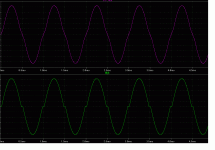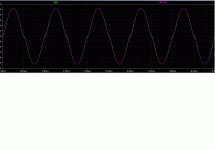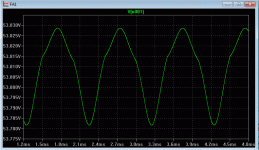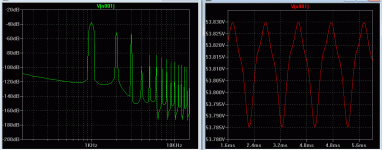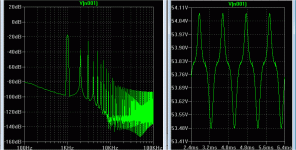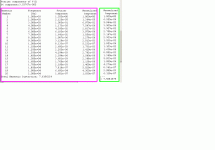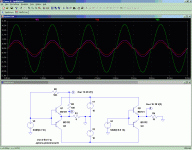Hi,
This thread has drifted off-topic, but in a direction worth investigating further.
Let us begin with a small quiz.
a)Which of the following waveform has, in your opinion, the highest distortion level: is it 1 (magenta) or 2 (green).
b)More controversial: which of the waveform has the most offensive distortion contents?
Think carefully before giving your answers.
In due time, I will reveal how the signals were created.
This thread has drifted off-topic, but in a direction worth investigating further.
Let us begin with a small quiz.
a)Which of the following waveform has, in your opinion, the highest distortion level: is it 1 (magenta) or 2 (green).
b)More controversial: which of the waveform has the most offensive distortion contents?
Think carefully before giving your answers.
In due time, I will reveal how the signals were created.
Attachments
Never had a meter, don't have an informed opinion. The high frequencies in the green would stand out to the ear because there isn't any high freq in the fundamental to cover it up. Psychoacoustics. The magenta wiggle, I don't know what it would sound like but it is low freq distortion. Its more of a reed stop than a flute stop. Doesn't have the right angle turn of the green.
I can spot clipping, hum, and high freq switch noise distortions with my eyes, and minimize.
I can spot clipping, hum, and high freq switch noise distortions with my eyes, and minimize.
Last edited:
Magenta = highest distortion
Green = most offensive (high, odd order)
Total agreement , and neither are clipping as well. You can get either one by building an amp wrong.
OS
Are you that sure?I can spot clipping, hum, and high freq switch noise distortions with my eyes,
Obviously, if I launched this discussion, it is because the matters are highly counter-intuitive.
And if chose this title, there has to be a good reason.
Any afterthoughts?
If the fundamental wave was at a multiple or sub-multiple of the power line frequency, I would miss hum. At non-integer frequencies, hum makes the tips bounce up and down at the power line freq. Standard piano frequencies are 58.3 Hz and 61.7 so if the source is music this shouldn't be a problem.Are you that sure?
Obviously, if I launched this discussion, it is because the matters are highly counter-intuitive.
And if chose this title, there has to be a good reason.
Any afterthoughts?
Last edited:
a - don't know (possibly magenta, as it could have lots of low order distortion but I am not sure)
b - green (more high order distortion because of a sharp transition)
Both waveforms look symmetric, so distortion will be odd-order. The green one is just crossover distortion - zero gain around the zero crossing. The magenta one could just be something like half of green plus half of undistorted sine wave. In either case it looks like just a few percent distortion.
b - green (more high order distortion because of a sharp transition)
Both waveforms look symmetric, so distortion will be odd-order. The green one is just crossover distortion - zero gain around the zero crossing. The magenta one could just be something like half of green plus half of undistorted sine wave. In either case it looks like just a few percent distortion.
Magenta = highest distortion
Green = most offensive (high, odd order)
I was going to say the same, but that seems too easy
Then I was thinking, what if you take the green wave and start adding more harmonics in the right phase? I think you could then get the mangenta one. Which means the mangenta would have more absolute distortion.
Audibility? If the green has a certain 'audibility' and you add harmonics? Would it start to sound worse or better? Would it depend on some sort of masking?
I know, questions, questions...
jan didden
My guess is the %THD+N is equal. I'd think the signal with the greater HF components (green) would be the worst sounding since you could easily separate the HF tone from the fundamental. But, I've been wrong so many times that it doesn't bother me in the least anymore.
Conrad
Conrad
I reproduced the waveforms at the threads beginning along with a FFT of both. LT spice agrees... Combined with this applet : Guitar Distortion 101 , I have my proof.
I have also actually seen these waveforms on real amps , some were actually OEM.
Below a = loaded VAS
Below b = loaded "sagging" output stage - underbiased (AB) Even with more bias , FFT was odd order dominant
OS
I have also actually seen these waveforms on real amps , some were actually OEM.
Below a = loaded VAS
Below b = loaded "sagging" output stage - underbiased (AB) Even with more bias , FFT was odd order dominant
OS
Attachments
Some interesting thoughts there, in particular from DF96 and Conrad.
Now, here is the distortion profile for both waveforms.
This seems to confirm the opinion of AKSA, and some others.
The THD figure is almost identical, the magenta is marginally higher, but it isn't very significant.
The green trace shows more higher distortion components, and should therefore be more offensive to the ear.
But when you know how the waveforms were created, you could have some doubts.
Now, here is the distortion profile for both waveforms.
This seems to confirm the opinion of AKSA, and some others.
The THD figure is almost identical, the magenta is marginally higher, but it isn't very significant.
The green trace shows more higher distortion components, and should therefore be more offensive to the ear.
But when you know how the waveforms were created, you could have some doubts.
Attachments
Here are the circuits that generated the waveforms:
Basically, the magenta trace is a 1:1 mix of "clean" and distorted signals.
With this ratio of amplitudes and the harmonics non shifted in phase, the waveform looks distorted, but smooth.
This of course is an illusion: the red waveform is grossly distorted, and diluting it by 6dB will make it only a little less offensive.
Note that the red waveform is much more distorted than V2: this is because the amplitude of V2 has been increased in order to equalize the THD's of V1 and V2.
It is true that V2 contains more higher harmonics, but this is because the "flat" part of the waveform is shorter.
That's the reason why I said the subject was controversial.
There can be little doubt that the red waveform is more offensive than the green.
Yet the green waveform has a greater high frequency contents because the crossover distortion is smaller.
If you go to the end of this reasoning, you have to say that the smaller the crossover distortion is, the more offensive it is.....
Somewhat paradoxical.
In summary, a visual smooth waveform such as the magenta one can in fact be very nasty from an audio perspective. Is it nastier than the green, I don't know, but the subject is at least debatable, and even if it less offensive, it can only be marginally so.
Basically, the magenta trace is a 1:1 mix of "clean" and distorted signals.
With this ratio of amplitudes and the harmonics non shifted in phase, the waveform looks distorted, but smooth.
This of course is an illusion: the red waveform is grossly distorted, and diluting it by 6dB will make it only a little less offensive.
Note that the red waveform is much more distorted than V2: this is because the amplitude of V2 has been increased in order to equalize the THD's of V1 and V2.
It is true that V2 contains more higher harmonics, but this is because the "flat" part of the waveform is shorter.
That's the reason why I said the subject was controversial.
There can be little doubt that the red waveform is more offensive than the green.
Yet the green waveform has a greater high frequency contents because the crossover distortion is smaller.
If you go to the end of this reasoning, you have to say that the smaller the crossover distortion is, the more offensive it is.....
Somewhat paradoxical.
In summary, a visual smooth waveform such as the magenta one can in fact be very nasty from an audio perspective. Is it nastier than the green, I don't know, but the subject is at least debatable, and even if it less offensive, it can only be marginally so.
Attachments
Green suffers huge amount of cross-over distortion, little or no harmonic artefacts. As Godfry says it will sound terrible when played softly. Magenta would seem to consist of possibly two separate signals mixing at 2x or 3x of fundamantal, it will sound like two signals beating.
High order harmonics is not necessarily offensive to the ear as every instrument has harmonic content, it is the order and amplitude that makes one instrument or voice sound different from another. Percussion instruments like a snare drum for instance has the most high order harmonics and it could be very offensive if you gave one to a three year old at Christmas, I guess.
Cross-over distortion is not harmonically related and sounds horrible, harmonically related artefacts are more tolerable.
Cross-over distortion is not harmonically related and sounds horrible, harmonically related artefacts are more tolerable.
As indicated by the schematic, magenta is a mix of the red (which has an even larger amount of crossover distortion than the green) and the clean signal.Green suffers huge amount of cross-over distortion, little or no harmonic artefacts. As Godfry says it will sound terrible when played softly. Magenta would seem to consist of possibly two separate signals mixing at 2x or 3x of fundamantal, it will sound like two signals beating.
There will not be any beating, because the signals are harmonically related and have a stable phase.
This opinion is interesting, and that's exactly the kind of debate I wanted to spark by launching this discussion.High order harmonics is not necessarily offensive to the ear as every instrument has harmonic content, it is the order and amplitude that makes one instrument or voice sound different from another. Percussion instruments like a snare drum for instance has the most high order harmonics and it could be very offensive if you gave one to a three year old at Christmas, I guess.
Note that I don't necessarily agree, I'm sitting on the fence.
Xover is harmonically related. It does sound horrible nevertheless.Cross-over distortion is not harmonically related and sounds horrible, harmonically related artefacts are more tolerable.
An example of non-harmonically related distortion is that produced by class D amplifiers.
- Status
- This old topic is closed. If you want to reopen this topic, contact a moderator using the "Report Post" button.
- Home
- Amplifiers
- Solid State
- Remember: you don't hear with your eyes....
